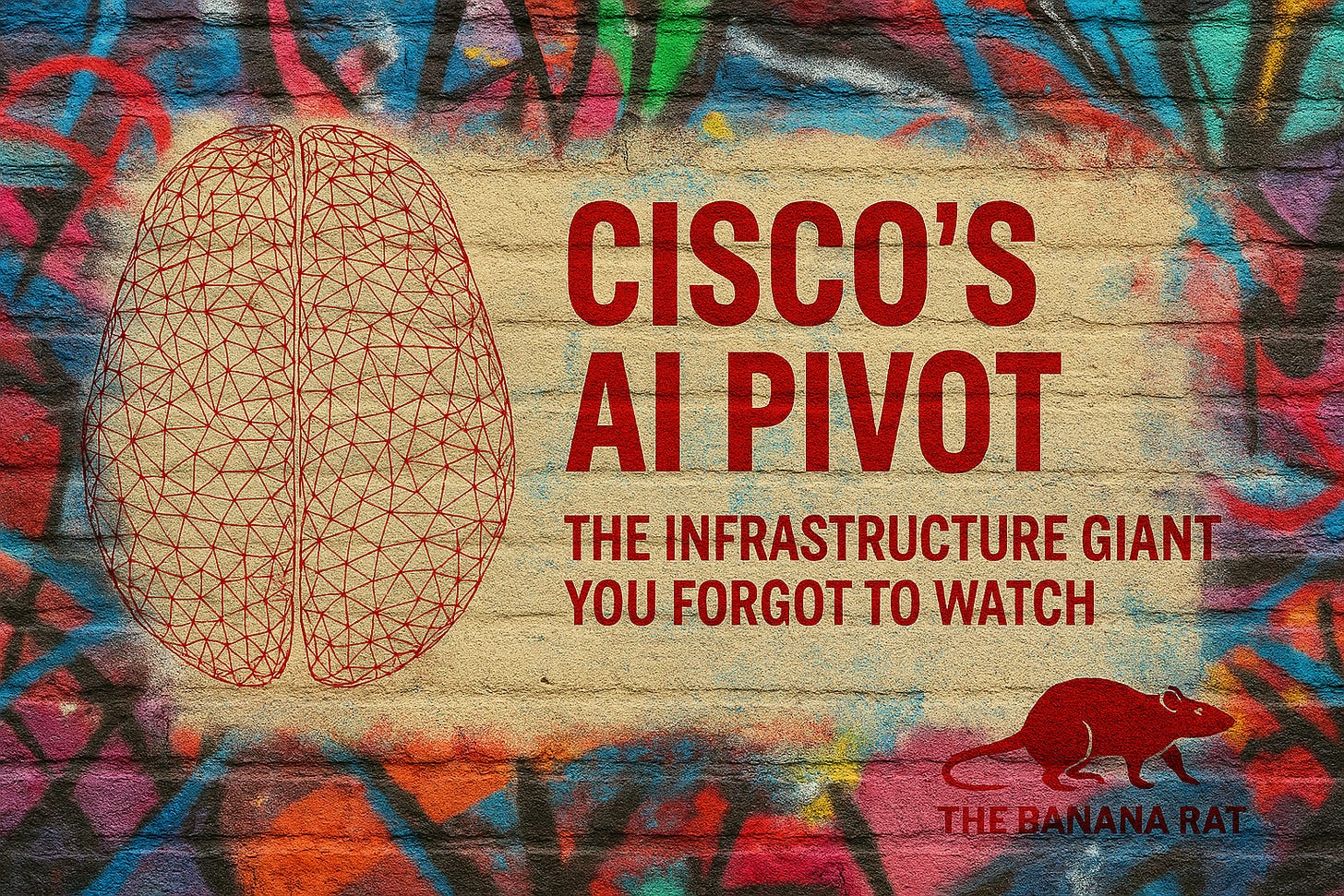Cisco’s AI Pivot: The Infrastructure Giant You Forgot to Watch
Let’s unpack it.
✅ Strengths – The Foundation Few Are Watching
Cisco’s strength doesn’t come from being sexy — it comes from being everywhere. You can’t build an AI factory, deploy 5G robotics, or run secure real-time inference at the edge… without running through a Cisco pipe somewhere.
Expanded Breakdown:
-
Global Network Dominance: Cisco still owns over 40% of the enterprise networking market. In hyperscale AI deployments, reliable backbone infrastructure is everything. When NVIDIA drops Blackwell chips into a factory, they still need Cisco’s lanes to move the data.
-
Cash Hoard & M&A Power: With over $26B in cash and equivalents, Cisco has Microsoft-style optionality without the flashy price tag. Their recent $28B acquisition of Splunk brings AI-native observability + cybersecurity telemetry — a perfect pairing for zero-trust AI networks.
-
Software Shift: 43% of revenue now comes from software and recurring subscriptions (2024 earnings), which shows the pivot is real. Think Adobe’s transition from box software to SaaS — same playbook, infrastructure edition.
-
Banana Rat Alignment: This is Layer 2 in your stack — beneath AI chips (Nvidia) and AI logic (Cohere), Cisco controls the digital highways. As the Banana Rat says: Follow the Stack post. This kind of foundational control is where real wealth concentrates.
⚠️ Weaknesses – The Price of Reinvention
Every legacy giant trying to pivot to AI eats the same meal: complexity, inertia, and image problems. Cisco is no different — but it’s worth asking whether those weaknesses are fatal, or just friction.
Expanded Breakdown:
-
Legacy Stigma: Cisco is still branded in many minds as a 2000s-era router company. That perception hides the transformation that’s been happening under the hood — especially as it pushes into cloud-native solutions, full-stack observability, and AI-powered security.
-
Product Integration Drag: Big acquisitions like AppDynamics and Splunk add power — but integrating them into one seamless AI-driven platform takes time. While competitors like Arista are built cloud-native from Day 1, Cisco’s integration must be earned.
-
Transition Tensions: Balancing old-school hardware sales with high-growth software subscriptions is like running two companies at once. Margins improve long-term, but quarterly volatility is real.
-
Strategic Insight: This is where Banana Rat radar activates: Don’t confuse slow transformation with stagnation. IBM had the same vibe pre-Watson. Then it became AI’s enterprise ambassador. Cisco’s transition echoes that — only with better timing and infrastructure leverage.
🚀 Opportunities – The Hidden AI Gold Mine in Network Data
If data is the new oil, then network data is the refinery — and Cisco owns the pipes, pumps, and telemetry.
The biggest under-discussed opportunity in AI isn’t the models. It’s the real-time data feeds that models use to learn, infer, and react. That’s where Cisco’s next act begins.
Expanded Breakdown:
-
AI-Driven Network Management: With tools like Cisco AI Cloud Network and the Splunk acquisition, they’re building self-healing networks that respond to load, threat, and usage patterns in real time. This reduces downtime and increases performance — and it’s sticky as hell.
-
Cybersecurity Expansion: Post-Splunk, Cisco is uniquely positioned to merge network traffic visibility with real-time threat detection. The security + observability + AI combo becomes a flywheel.
Referencing your project: This fits squarely into the Quantum-Safe Infrastructure + Cyberstack thesis. Just as BTQ hardens the crypto layer, Cisco is embedding resilience into the communication backbone.
-
Edge + 5G Infrastructure: AI at the edge needs low latency, high throughput, and real-time failover. Cisco's growing 5G portfolio (with private 5G + Wi-Fi 6E) is setting it up as a key enabler of AI robotics, AVs, and smart factories — which we highlighted in the Honeywell Quantum + Edge stack posts.
-
Emerging Market Growth: While North America is mature, AI/5G deployments in Asia, Africa, and LATAM are surging — and Cisco is already embedded via government and telco contracts.
🛑 Threats – The Rivals and Risks on the Road Ahead
Every empire faces challengers. Cisco’s is no exception. From nimble startups to global volatility, here’s what could slow the AI pivot.
Expanded Breakdown:
-
Cloud-Native Competitors: Arista Networks, Juniper, and Palo Alto Networks are eating into Cisco’s pie by being more agile. Arista, in particular, is beloved by hyperscalers and Wall Street for its lean margins and software-defined everything.
-
Commoditization Pressure: Open-source and cheaper alternatives (especially in emerging markets) threaten Cisco’s price premium. But their response — AI feature bundling and turnkey security — is designed to combat that.
-
Geopolitical + Supply Chain Risk: Like all hardware-adjacent players, Cisco is exposed to chip shortages, regional export controls (China tensions), and raw material bottlenecks. The Splunk pivot reduces hardware dependency but doesn't eliminate it.
-
Economic Cycles: Enterprise IT spend is still cyclical. In a recession, hardware refresh cycles extend. That said, Cisco’s recurring software revenue is anticyclical and defensive — a key distinction if volatility spikes.
🧠 Final Strategic Insight – This Ain’t Just a Router Company Anymore
Cisco is becoming something rare:
A legacy company that’s actually winning the AI transition — not by trying to be a model company, but by owning the terrain that models run on.
It’s a deep infrastructure layer stock. Not as flashy as Nvidia. Not as new as CoreWeave. But potentially just as essential.
If you believe in:
-
AI at the edge
-
Cybersecurity convergence
-
Sovereign compute + observability
-
Infrastructure as a moat
…then you’d be smart to watch Cisco like a hawk.
This is not hype.
It’s bandwidth, telemetry, and control.
🔐 Infrastructure always wins in the long run.
The 🍌🐀 has spoken.

Leave a comment